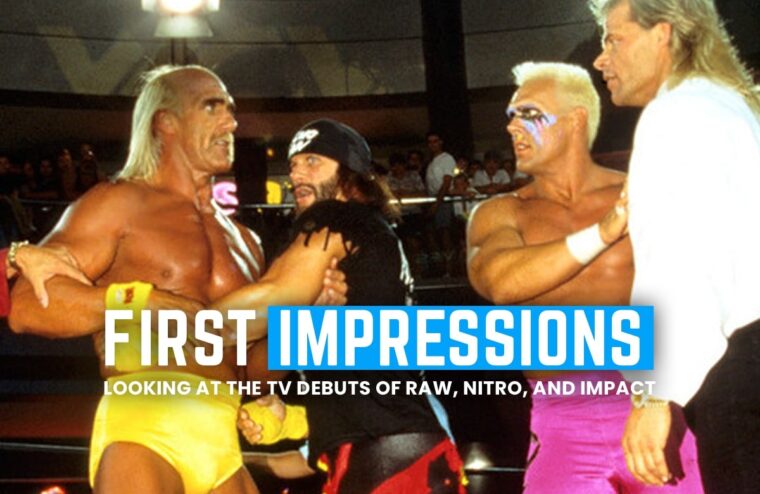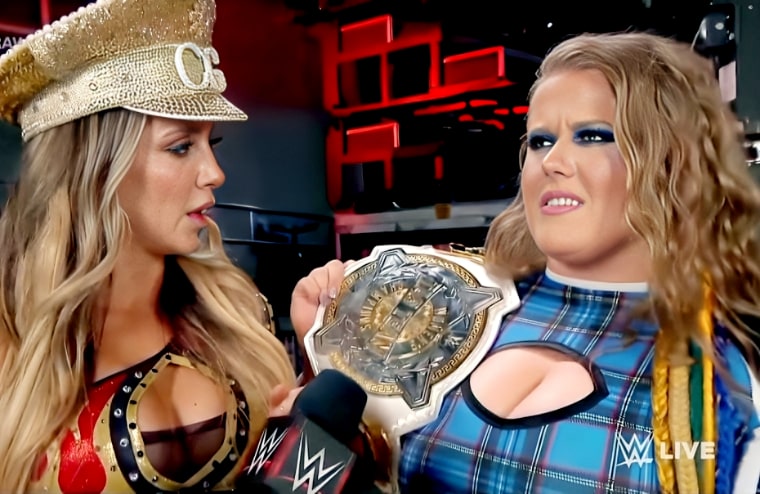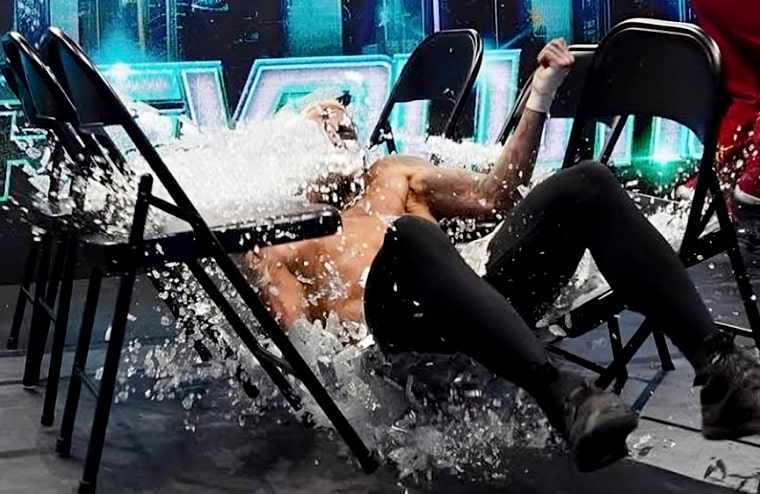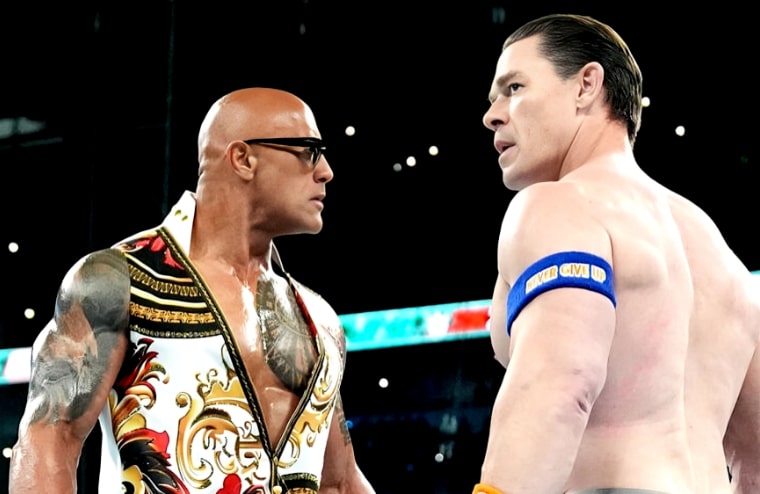October 2, 2019. On that night, All Elite Wrestling will debut their weekly two-hour live program on TNT. While the company has already produced several live events on Pay-per-view, and a slew of online content, this is obviously a huge step for a company that plans to legitimately challenge WWE’s 18-year stranglehold on the top spot of the wrestling industry. How will they present their product to not just the diehard fans who already follow it, but the mainstream casual viewer who checks it out for the first time?
Debuting a prime-time show on a major cable channel is nothing new in professional wrestling, so I thought it would be interesting to look back on three other “big debuts” from professional wrestling companies on major TV outlets, and what might be learned for those historic shows.
January 11, 1993 – WWE debuts Monday Night Raw
For years, Prime Time Wrestling was the then-WWF’s flagship show, featuring studio segments hosted by Gorilla Monsoon and Bobby Heenan for the majority of the show’s run (it used a roundtable of hosts near the end), alongside a slew of mostly one-sided enhancement matches with the occasional competitive arena bout thrown in. The show was replaced in 1993 by Monday Night Raw, which would air live (most weeks) and promised to be “Uncut, Uncensored, Uncooked.” The first episode aired live from the Manhattan Center in New York City.
Match Results:
– Yokozuna defeated Koko B. Ware with a Bonsai Drop.
– Rick & Scott Steiner defeated The Executioners with a top rope bulldog.
– Intercontinental Champion Shawn Michaels defeated Max Moon with a teardrop suplex.
– The Undertaker defeated Damien Demento with a tombstone.
Angles:
– Doink The Clown, then a heel, was in the crowd, setting up him being confronted and chased by Crush, who was annoyed with him upsetting young fans.
– An on-going bit had Bobby Heenan trying to get into the sold-out show by wearing various disguises.
– Vince McMahon interviewed Razor Ramon about his upcoming WWF World Title match with Bret Hart at the Royal Rumble.
– Recaps of angles with Razor Ramon attacking Owen Hart and Kamala’s babyface turn by joining with Slick and leaving Harvey Wippleman from other WWF programs were shown.
– Mean Gene Okerlund hyped the upcoming Royal Rumble PPV in a pre-taped segment, announcing more names for the Rumble and that Marty Jannetty would challenge Shawn Michaels for the Intercontinental Title with Sherri Martel at ringside.
Thoughts:
Watching Raw for the first time, I was totally underwhelmed. We gave up two hours of Prime Time Wrestling for one hour of Raw, and at the time it really seemed to make no sense at all. The Yokozuna, Steiners and Undertaker matches were three-minute squashes, while only Michaels vs. Moon was competitive, going about nine minutes. The Doink-Crush angle and Razor interview was about it for building to the future on the live show. The Heenan bit was worth a chuckle, but the decision to have him out of the booth (commentary was handled by Vince McMahon, Randy Savage and comedian Rob Bartlett) was a mistake (which was soon rectified, as they got Heenan on the team in place of Bartlett).
There was far too much of a forced attempt to be funny and topical, such as announcing a Woody Allen vs. Mia Farrow (their messy divorce in the news) match for the following week. Also, while the Manhattan Center is a great intimate venue to watch a show as a fan in attendance, on television it just looked tiny. At this point, WWF had become masters of making their television product massive, filming in arenas and creating long entrance aisles that, when filmed right, made the venues look huge. It felt like they went from Nassau Coliseum to a clubhouse.
What can AEW learn from this?
– Don’t experiment on Night One. AEW has the benefit of doing several televised events now, so they should take the knowledge they have gained regarding what looks and sounds good, and what doesn’t. This is not the night to bring in a new announcer or try to become anything but a quality wrestling show.
– Limit the squash matches. There’s nothing wrong with an occasional one-sided bout to put over a character in a big way, but three squash matches (and WWF’s other shows were already filled with squash matches) made the first Raw feel like anything but special.
– Hype the upcoming events. One thing WWF did right on Raw was make the upcoming Royal Rumble later that month seem special. They announced Rumble entrants, a Shawn Michaels vs. Marty Jannetty match, and hyped the debut of the Narcissist (Lex Luger) for the PPV.
September 4, 1995 – WCW debuts Monday Nitro
After years of the 6:05 TBS show (at this point called WCW Saturday Night) being the flagship of the company, the Eric Bischoff-led company made the aggressive move of going on Monday night on TNT, opposite Raw on the USA Network (not coincidentally, this debut was on a Monday when Raw was preempted). The first edition broadcast from the middle of the Mall Of America in Minnesota, giving it a unique look. Future editions would be held in arenas, but it would always broadcast live, something Bischoff, as play-by-play man would constantly point out (Raw at the time alternated between live and taped shows). This was the start of the Monday Night War that would change the industry forever.
Match Results:
– Brian Pillman defeated Jushin Liger with a rollup.
– United States Champion Sting defeated Ric Flair via disqualification when Flair refused to release the figure-four after the referee called for a rope break.
– WCW World Champion Hulk Hogan defeated Big Bubba Rogers with a legdrop.
Angles:
– Vignettes were shown setting up the debuts of Sabu and Michael Wallstreet (who mocked his former IRS persona from WWF).
– Lex Luger made his surprise return to WCW, appearing in the aisle during the Sting vs. Ric Flair match, having jumped from the WWF.
– Arn Anderson brawled with Ric Flair after his match with Sting, continuing their storyline.
– Scott Norton appeared at ringside following the Sting-Flair bout, demanding a match. Randy Savage came out to confront him, until security took Norton away, setting up a Savage-Norton bout for the following week.
– The Dungeon of Doom attacked Hulk Hogan after his win, with Lex Luger making the save. Luger revealed he wanted the WCW World Title, and Hogan agreed to a title match for the following week. The two shoved each other with Sting and Savage breaking it up.
Thoughts:
WCW came out swinging on this show. The Mall Of America setting gives the show a strange backdrop and less enthusiastic crowd, but it did allow them to plug Hulk Hogan’s “Pastamania” restaurant (priorities, people!). The show featured the top stars in the company at the time, and all three matches were competitive bouts, even if they weren’t PPV length. Steve McMichael’s debut on the mic showed why he is celebrated as a great football player, because he is a lousy announcer. Eric Bischoff is in full “hype man” mode, and you can start to see how Bobby Heenan wasn’t enthralled with the dynamic in the booth.
Bischoff wanted to put on an alternative to Raw, and he did so here. No squash matches, top stars in feature bouts, and an emphasis on surprises and being unpredictable. In addition, this first episode did a great job setting up the following week’s Luger vs. Hogan and Savage vs. Norton matches. While Nitro wouldn’t really “click” until the formation of the NWO, there was an effort from the start to make Nitro a “must see” show, even if it came at the expense of their other programs (including PPVs).
What can AEW learn from this?
– Hype the matches during the show. With the exception of Pillman vs. Liger, which opened the program, the other two bouts were hyped throughout the program with interview segments. Nothing was sent to the ring “cold” so to speak.
– Use the star power. The biggest stars in the company at this time were Hogan, Savage, Sting and Flair and all of them were front and center, with three of them in advertised matches. Also, their appearances were connected to the following week’s show for the most part, giving fans a reason to stay tuned in.
– Surprise, surprise, surprise. Regardless of what happened going forward, Nitro allowed Lex Luger and Scott Norton to have impactful debuts, while also hyping Sabu (who had built up a huge following in ECW, Japan and independents) and Michael Wallstreet (may not seem like a big deal, but he had been a regular presence on WWF programming for a long time).
– Oh, and much like Raw, don’t debut an announcer who has never called wrestling before. Yes, Mongo lasted longer than Rob Bartlett, but that doesn’t mean it was any better.
October 1, 2005 – TNA debuts Impact on SpikeTV
Total Nonstop Action (now known as Impact Wrestling) had been producing weekly television since 2002, TNA Xplosion, while still using their weekly Pay-per-view business model. In 2004, they launched Impact on Fox Sports Net. However, it was in 2005 that they gained a spot on SpikeTV, giving them prime-time exposure on a much larger cable channel than they had previously enjoyed. This was seen as a big step towards TNA being seen as a legitimate competitor to WWE. TNA continued to tape and post-produce their shows, unlike the Nitro model of being live every week.
Match Results:
– X Division Champion AJ Styles defeated Roderick Strong with a Styles Clash.
– Monty Brown defeated Lex Lovess with the Pounce.
– Chris Sabin defeated Petey Williams and Alex Shelley in a three-way match by pinning Shelley with the Cradle Shock.
– Rhino vs. Jeff Hardy ended in a no-contest when Abyss and James Mitchell interfered.
Angles:
– Raven, angry over Jeff Jarrett beating him for the NWA World Title in Canada, attacked people backstage and was ejected from the building.
– Christopher Daniels watched the Styles-Strong match from the aisle in advance of his Ironman match with Styles at Bound For Glory.
– MMA star Tito Ortiz appeared and had a meeting with Larry Zbyszko (which would set up Ortiz appearing at the Bound For Glory PPV as a referee).
– After Abyss interfered in the Rhino-Hardy match, the lights went out and Sabu appeared, leading to a brawl amongst the competitors, who would be in the Monster’s Ball match at Bound For Glory.
– A show closing promo by Jeff Jarrett & America’s Most Wanted was interrupted by 3 Live Kru (Konnan, BG James & Ron Killings). A brawl between them led to Team Canada joining in to help the heels, then Team 3D (Dudleys) made their surprise TNA debut, clearing the ring. Jarrett attempted to escape but was stopped by Kevin Nash. Team 3D hit the What’s Up headbutt on Jarrett, then Nash powerbombed him, before announcing he would face Jarrett at Bound For Glory.
Thoughts:
This is going to come as a shock to some, since TNA is rarely seen as being superior to WWE and WCW in the annals of history… but TNA did a LOT more with their one hour than the first Raw or Nitro did. They put over Monty Brown (who they were building up) in a squash, but the other three matches were competitive, and all tied into upcoming matches at the Bound For Glory Pay-per-view. They debuted Team 3D in a big surprise, which set up Team 3D vs. America’s Most Wanted for the following week’s show. The World Title was given attention, with the fallout from Raven’s loss and Kevin Nash’s appearance to challenge Jarrett for the PPV.
TNA displayed the athleticism of their X-Division and the “car crash” excitement of what I guess we can call their “hardcore division” while also putting over a lot of their performers in a show that actually had quite a bit of energy throughout. They also put a lot of attention on their PPV, making Bound For Glory out as a big event. Unfortunately, Kevin Nash’s health scare derailed the main event (and a planned Nash-Raven angle), which may be why people don’t reflect as fondly on the show. In many ways, this was TNA’s legacy, just when it seemed they were on the verge of taking the next step, something (either outside or inside) kept it from happening.
What can AEW learn from this?
– Plug that PPV. Yes, you want people to enjoy the program and tune in the following week, but you also want to convert them into paying customers that will by PPVs (online or traditional) and merchandise. TNA did a great job of making you feel like Impact was just a sample of what you would get at Bound For Glory.
– Proper use of a squash match. Monty Brown’s win took one minute and he came out of it looking awesome. The fact it was the only enhancement match made it stand out on the card as well.
– Be careful of overloading a segment. While the end of the show came across well, you could accuse TNA of overbooking the segment. The Team 3D debut and Kevin Nash powerbomb stood out, probably to the point that the 3 Live Kru and Team Canada involvement could almost be forgotten.
– When it comes to announcing, stick with what works. Unlike the Raw and Nitro shows I mention above, TNA stuck with their regular announce team of Mike Tenay and Don West, and didn’t insert a first-time wrestling announcer into the mix (wisely).
You can check out last week’s column, “Who Was First? Wrestling’s Inaugural Champions” and all of my past work here on WebIsJericho.com.
- The ECW Matches We Didn’t Get: Shane Douglas vs. Brian Pillman - May 8, 2021
- The ECW Matches We Didn’t Get: Public Enemy vs. Bubba Ray & D-Von Dudley - April 14, 2021
- The ECW Matches We Didn’t Get: Mike Awesome vs. Rob Van Dam - April 4, 2021




